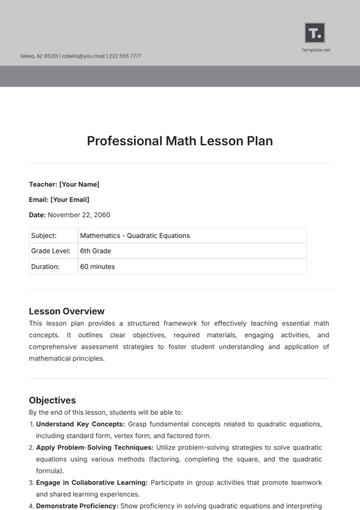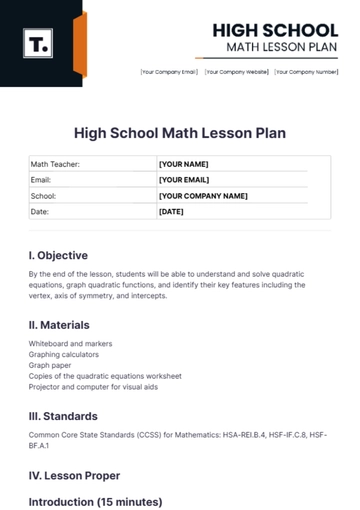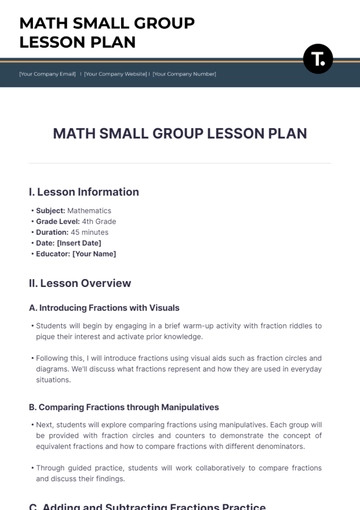Free High School Math Lesson Plan

Math Teacher: | [YOUR NAME] |
Email: | [YOUR EMAIL] |
School: | [YOUR COMPANY NAME] |
Date: | [DATE] |
I. Objective
By the end of the lesson, students will be able to understand and solve quadratic equations, graph quadratic functions, and identify their key features including the vertex, axis of symmetry, and intercepts.
II. Materials
Whiteboard and markers
Graphing calculators
Graph paper
Copies of the quadratic equations worksheet
Projector and computer for visual aids
III. Standards
Common Core State Standards (CCSS) for Mathematics: HSA-REI.B.4, HSF-IF.C.8, HSF-BF.A.1
IV. Lesson Proper
Introduction (15 minutes)
1. Begin with a brief review of linear equations and their graphs.
2. Introduce the concept of quadratic equations in the form \( ax^2 + bx + c = 0 \).
3. Highlight the differences between linear and quadratic equations.
4. Explain the significance of the coefficients \( a \), \( b \), and \( c \) in determining the shape and position of the parabola.
Direct Instruction (20 minutes)
1. Demonstrate how to solve a quadratic equation by factoring.
2. Explain the Zero Product Property and how it’s applied in solving quadratic equations.
3. Introduce the Quadratic Formula: \( x = \frac{-b \pm \sqrt{b^2 - 4ac}}{2a} \). 4. Work through examples using the Quadratic Formula. 5. Show how to complete the square to solve a quadratic equation.
Guided Practice (20 minutes)
1. Distribute the quadratic equations worksheet.
2. Have students work on the first few problems in pairs, and then review the solutions as a class.
3. Monitor and assist students as they practice solving quadratic equations.
4. Use a projector to graph a quadratic function using the example problems, demonstrating the vertex, axis of symmetry, and intercepts.
Independent Practice (20 minutes)
1. Assign the remaining problems on the worksheet for individual practice.
2. Encourage students to use graphing calculators to verify their solutions and to graph the quadratic functions.
3. Circulate around the classroom to provide support and answer questions as needed.
Closure (10 minutes)
1. Summarize key points learned in the lesson, such as solving quadratic equations and graphing parabolas.
2. Highlight the importance of understanding the properties of quadratic functions in real-world applications.
3. Answer any remaining questions from students.
4. Provide a brief preview of the next lesson on applications of quadratic functions.
V. Assessment
Formative assessment through observation during guided and independent practice.
Collect and review the quadratic equations worksheet to evaluate understanding. Quick exit ticket quiz with a couple of problems to solve and graph.
VI. Homework
Assign a set of problems from the textbook that include solving quadratic equations by different methods and graphing quadratic functions.
VII. Extensions
For advanced students, introduce the concept of the discriminant and how it determines the nature of the roots of a quadratic equation.
Provide additional challenges involving word problems that can be modeled using quadratic equations.
VIII. Accommodations
Provide step-by-step guides and extra practice sheets for students who need additional support.
Allow the use of graphing calculators for students who struggle with visualization.
Offer one-on-one or small group tutoring sessions during lunchtime or after school.
IX. Reflection
After the lesson, reflect on which methods were most effective for teaching quadratic equations and functions.
Gather feedback from students about which parts of the lesson were most and least clear.
Adjust future lesson plans based on student performance and feedback.
Connect with us on social media: [Your Company Social Media]
This lesson plan was prepared by [Your Name]. For further questions, please contact [Your Email].
- 100% Customizable, free editor
- Access 1 Million+ Templates, photo’s & graphics
- Download or share as a template
- Click and replace photos, graphics, text, backgrounds
- Resize, crop, AI write & more
- Access advanced editor
Discover the ultimate ally for high school math educators – the High School Math Lesson Plan Template from Template.net. Crafted to perfection, this resource is your blueprint for seamless lesson planning. Fully editable and customizable, it's your canvas to paint engaging, tailored lessons. Utilize the AI Editable Tool for effortless modifications. Elevate your teaching with precision and ease.



